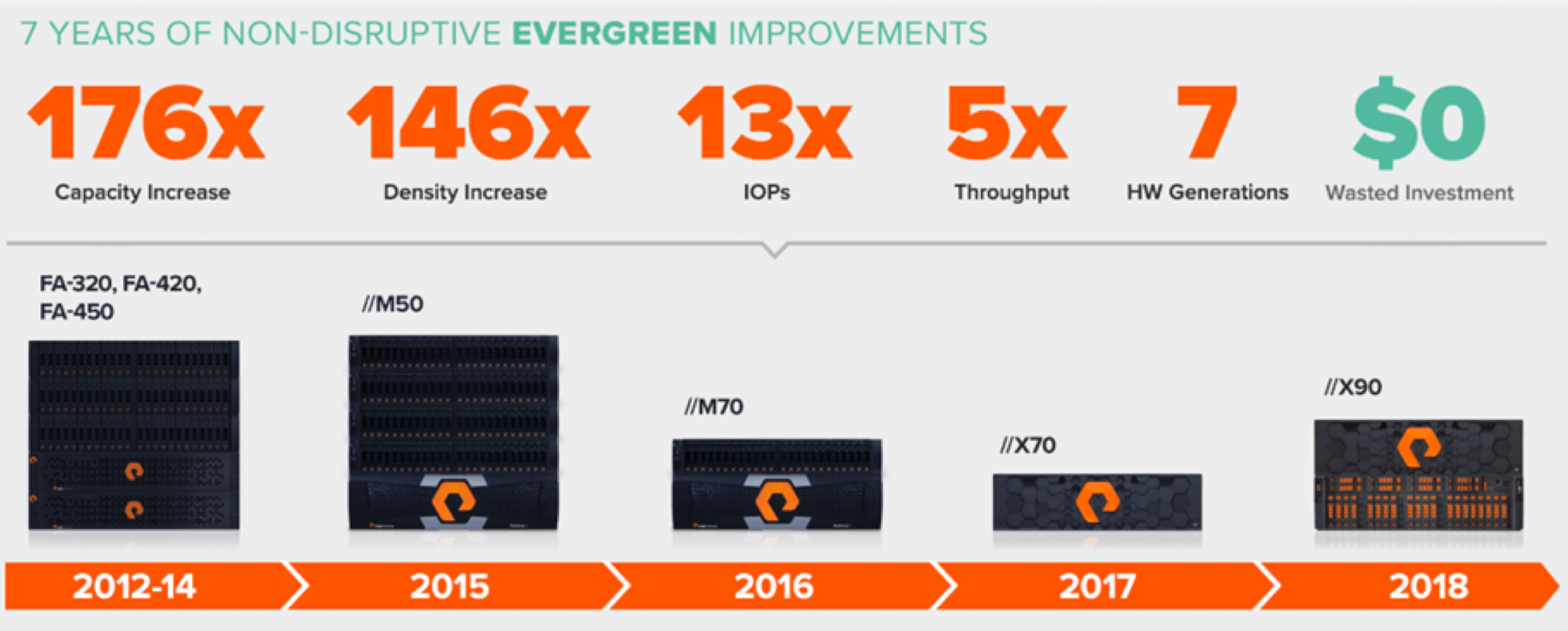In the last few weeks CRN has published articles quoting Dell sources implying that the four different midrange storage product architectures at Dell will all be converged into one single midrange platform in the future. If you are either a current or expectant customer of any of Dell’s midrange storage products, you may have some reasons to be concerned and pay attention.
HPE’s Phil Davis was the first competitor to publicly expose what this will likely mean for customers in this CRN article.
Dell’s Jeff Clarke has now responded publicly to those claims, but in our mind the response possibly raises even more questions than it answers.

Let’s examine the Dell responses in the article, discuss the implications, offer some questions that you might want to ask, and suggest some alternative thoughts.
“Despite what may be being said by others, our products on the roadmap today are supported throughout their lifetime period and we will provide a non-disruptive migration from the old product to the new product,” said Clarke, vice chairman, products and operations for Dell, during the company’s first fiscal quarter earnings [6] call this week.
As usual, the details matter, so this statement raises some questions which we recommend you ask your Dell representative – let’s go through them.
What exactly does “supported” mean?
For example, can you keep it and still pay maintenance? For how long? How will that maintenance change (up or down) for what is now an N-1 generation architecture? Will there be higher maintenance costs, intended to drive you to the new product? From your own experience, if you were a VNX customer, what happened to your VNX maintenance cost when Unity was introduced? Do you expect any new feature enhancements to ever again be provided for the current product after the new product is announced?
The answer here matters a lot because at Pure, “supported” has a very different meaning, one that we believe is far more customer-friendly. Pure’s Evergreen™ subscription to innovation offers “flat and fair” maintenance with future new-technology controller upgrades and the addition of future array software features all included in the subscription. Our customers have enjoyed the ability to keep up-to-date with our latest capabilities and faster controllers supporting improved performance and capacity without having to migrate their data. This not only reduces TCO up to 50%, but provides for simple financial and operational planning without risk of obsolescence. While this innovative business model has delivered incredible value for customers, it is important to note that it is the underlying unique technical architecture of FlashArray that enables it. The non-disruptive migration capability of FlashArray helps eliminate conventional migrations and escalating maintenance. You can learn more about Pure’s innovative Evergreen program in this blog.

What exactly does “lifetime” mean?
Some IT architectures have endured across generations of products and incremental new technology, but most architectures have assumed that individual products would have a more limited life. The average practical life in production for most storage products has typically been affected by advances in new technology, but also the desire by vendors to sell you new products and retire the old ones – often at least every 3 to 5 years. What if you could get something more like Storage-as-a-Service (STaaS) instead? What if you could depreciate a storage product over 7 to 10 years, or even longer? This whitepaper describes how the unique architecture of FlashArray facilitates superior TCO and lower, more predictable costs.
What exactly does “Non-disruptive” mean?
EMC has shown that they can provide a “non-disruptive migration” between generations of some of their products, and they even guarantee it in their Future Proof Loyalty Program. The real question is, why migrate data at all?
Do I need both the old and new systems to coexist on my data center floor at the same time for the migration? For how long? How much of my staff should be involved in the migration, or will you do it for me? If so, at what cost? Should I consider extending the migration period to only occur during “off-peak” hours, or can I do it during live peak production hours without any performance risk? When migrating from old to new, do I have to pay for 100% of the new capacity, or do you give me credit for the existing capacity that I already paid for?
If you consider migrating from Dell-EMC storage (or anything else) to Pure Storage FlashArray, that data migration will be your last, allowing you to focus on adding higher-level value to your business. How is this possible? Our arrays are designed with a very flexible stateless architecture. Pure Storage FlashArray customers are accustomed to “data-in-place” non-disruptive controller upgrades that can occur even during peak production time without a performance impact. When moving to new generation storage devices, FlashArray customers do not have to rebuy all of their previous storage capacity. The data never moves! For more detail, here’s a blog covering how and why a non-disruptive upgrade with FlashArray is so different from other storage platforms.
Clarke said partners and customers are asking, “Jeff, we can buy what we’re buying today, and when Dell has the new thing ready, we can seamlessly migrate to the new thing?’ [My answer is,] ‘Yes sir, that’s correct.”
The key issue here of course is the interpretation of the word “seamlessly”. Will all of the features and functions of the product that you buy today all be available and functional in the same manner on the new platform? Will the management tools and interfaces that you use today all be the same on the new platform? Will the applications and other 3rd-party software that you use today be certified and supported at launch on the new platform by all of your software vendors? By “seamlessly migrate” does Dell *really* mean a “forklift”-style platform change and the associated data migration?
The other issue of course is, if Dell introduces a brand new product, isn’t it a “version 1.0” product? If you hold off on migrating your data onto the new platform, will your maintenance cost go up? Your choice typically is either to migrate to a new and not yet field-hardened platform, or be forced to pay extra for an essentially end-of-life product. With Pure, this difficult choice to date has not existed. FlashArray is a proven, non-disruptive platform with seven generations of proven reliability and availability in the field. Even as we changed generations, our customers who ran our original FA-300 and FA-400 generation products were protected, even when we changed the architecture of our controllers to our FlashArray//M generation, and now most recently to our FlashArray//X generation. They did not have to migrate data. Only Pure, with our non-disruptive architecture, engineered to be Evergreen, has been able to do that. This is a key unique differentiator for Pure. You will hear marketing claims from other vendors that sound similar to what we’ve done, but one can’t simply bolt on a marketing or financial program and deliver what Pure does. The difference is architectural and must be designed into the product.
“When I talked to customers and said, ‘Would you rather buy four midrange products or one, and the right one, with all of our best IP?’ The answer is overwhelmingly positive to the degree of 100 percent that, ‘We’d prefer to buy one product that’s the right product with all of the Dell technology and IP in it,’” said Clarke.
We believe that 100% of customers would say that they prefer one “right” product with “best IP” to four, why would anyone disagree with that? After all, that’s exactly what we’ve done for years with FlashArray – except our single FlashArray family also scales from the midrange up to the most demanding Tier-1 environments. Talk about simplicity – and our customers love it! But examples abound in the IT industry with failed attempts to consolidate and rationalize multiple product architectures into one new product with “100%” consistency with all of the previous products. The question is: has Dell demonstrated its ability to successfully carry forward 100% of the features of multiple architectures into one single new architecture, while maintaining (or improving) resiliency, performance, and manageability? That’s a really hard task, and judging from what we’ve seen, in our opinion the answer is simply, no. But of course, time will tell, and we look forward to objectively evaluating any new offering when it comes out – and watching to see how it holds up to the rigors of field production environments over the subsequent years while the new platform stabilizes.
Pure Storage’s FlashArray has proven itself to be a highly scalable and reliable storage architecture that has successfully transcended an incredibly wide range of applications and deployments. Pure customers that previously ran any of the products in the entire Dell storage portfolio – Symmetrix, DMX, VMAX, VNX, Unity, XtremIO, Isilon, SC Series, EqualLogic – have replaced each of those Dell products with FlashArray. FlashArray has shown it is possible for a single product architecture to address a huge portion of the market. But in stark contrast to the current challenge that Dell faces, FlashArray had the luxury of starting off without any legacy baggage to carry forward and with wisdom learned from all storage architectures that preceded it.
We would welcome the opportunity to show you how as a single product, FlashArray, can address most requirements that are covered by the breadth of Dell’s entire block storage product portfolio – past, present, or future. Many customers like you have already benefited from having taken that journey. Please contact us, and we can put you in touch with them so you can hear about their experience first hand!





